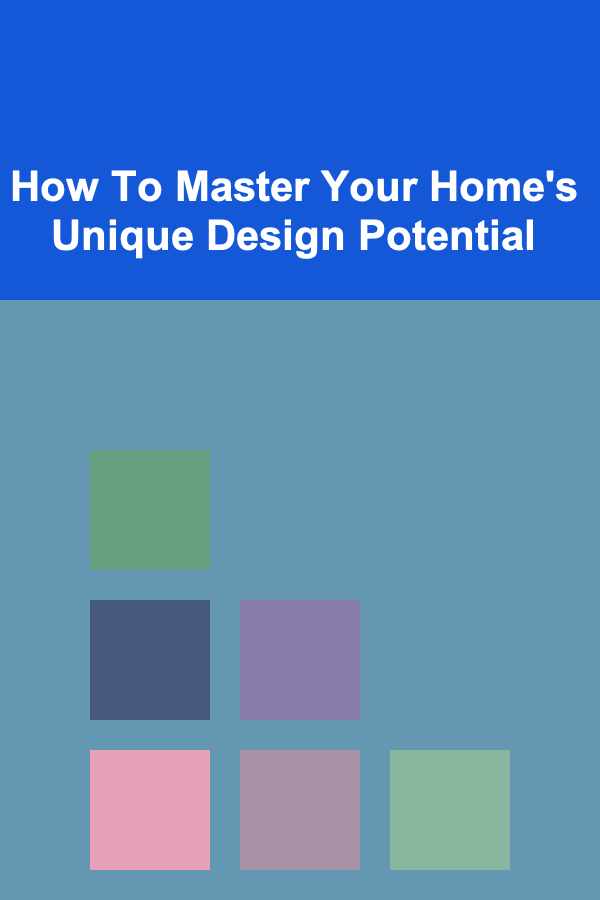
How To Master Your Home's Unique Design Potential
ebook include PDF & Audio bundle (Micro Guide)
$12.99$6.99
Limited Time Offer! Order within the next:

Every home, no matter its size or style, has inherent design potential. Whether you're living in a small apartment or a sprawling estate, understanding how to harness the unique characteristics of your living space can transform it into a personalized haven that reflects your personality, needs, and aspirations. This article explores how to master your home's unique design potential by focusing on various design principles, tips, and strategies that can elevate your living space to new heights.
Recognizing Your Home's Core Strengths
The first step in mastering your home's design potential is recognizing the core strengths of your space. Every home has certain features that make it unique, whether it's the architectural layout, the location, or natural elements like light and views. By identifying these strengths, you can use them as the foundation for your design approach. Here are some key elements to consider:
Architectural Features
Look at the structural elements of your home, such as vaulted ceilings, large windows, exposed beams, or interesting floor plans. These features can define the style and feel of your home. Emphasize them by using complementary decor that enhances their visual appeal. For instance, large windows can be framed with drapes or blinds that emphasize natural light, while exposed beams can be highlighted with a rustic or industrial decor theme.
Natural Light
Natural light is one of the most important elements in a home. It not only enhances the atmosphere but also has a significant impact on mood and well-being. Identify the areas where light pours into your home the most. If you have large windows in the living room, use sheer curtains to allow light to flood the space while adding some privacy. If your home has limited natural light, consider using light colors, mirrors, or reflective surfaces to brighten darker rooms.
Location and Views
If your home is situated in an area with breathtaking views, make sure to design your space around those vistas. Whether it's a city skyline, a lush garden, or a coastal panorama, orient your furniture and layout to maximize the visual impact. Use sliding glass doors, expansive windows, or outdoor terraces to create a seamless flow between the interior and exterior spaces.
Personalizing Your Space
One of the most powerful ways to master your home's design potential is to inject your personality and style into the space. Your home should feel like an extension of yourself, a place that reflects your tastes, hobbies, and lifestyle. Personalization doesn't necessarily mean filling every inch with items you've acquired over the years; it's about creating a cohesive, intentional space that feels uniquely yours.
Color Palette
Choosing the right color palette for your home is essential in creating an environment that complements your personality. Warm tones like terracotta, mustard, and earthy greens create a cozy, inviting atmosphere, while cooler tones like blues, grays, and whites evoke calmness and tranquility. Consider using your favorite colors as accent walls, throw pillows, or rugs. Don't forget the power of neutrals -- a well-chosen neutral base can help other elements in the room, like artwork or textiles, shine.
Art and Personal Items
Art is a great way to add personality to your home. Display artwork, photographs, or other creative pieces that resonate with you. This could include family portraits, travel souvenirs, or paintings that inspire you. Mix and match different mediums to add layers of interest to your walls, shelves, and surfaces.
In addition to art, consider incorporating personal items that hold sentimental value. Items like heirlooms, books, or objects from your travels can tell the story of your life and add authenticity to your home.
Design Themes
Selecting a design theme that aligns with your personal style is crucial to creating a harmonious space. Whether you prefer a minimalist aesthetic, bohemian vibes, or a more eclectic blend, having a clear design direction can help you make cohesive choices. Don't be afraid to experiment with different styles and integrate elements that speak to you, but always aim for balance. For instance, combining modern and vintage pieces can create a charming juxtaposition when done thoughtfully.
Maximizing Space Efficiency
While personalization is important, it's equally crucial to consider the functionality of your home. Efficient use of space ensures that your living environment supports your daily activities while feeling comfortable and free of clutter. This is especially important for smaller homes or apartments, where space can often feel limited.
Multifunctional Furniture
Multifunctional furniture is a game-changer when it comes to maximizing space. Pieces like fold-out desks, convertible sofas, and storage ottomans serve multiple purposes, making them ideal for smaller homes. When choosing multifunctional furniture, opt for sleek, modern designs that blend seamlessly with the rest of your decor.
For example, a dining table that doubles as a workspace or a bed with built-in storage can help you make the most of your space without sacrificing style or comfort.
Vertical Storage
In homes with limited floor space, vertical storage is your best friend. Consider installing floating shelves, tall bookcases, or wall-mounted storage units to keep your belongings organized while maintaining an open, airy atmosphere. Vertical storage not only helps you reduce clutter but also adds visual interest to your walls.
Open Floor Plans
If your home features an open floor plan, embrace it. Open-concept spaces allow for fluid movement between rooms and create a sense of spaciousness. Use furniture placement and rugs to define different zones within the space, such as a cozy reading nook or a dining area. Open floor plans are perfect for integrating different design elements, like incorporating a modern kitchen into a more traditional living room.
Incorporating Nature into Your Design
Nature has a profound impact on our well-being, and integrating natural elements into your home can elevate its design potential. Whether through natural materials, indoor plants, or outdoor spaces, nature helps create a calming and restorative environment.
Indoor Plants
Adding greenery to your home is an easy and effective way to breathe life into any room. Plants not only purify the air but also add color, texture, and freshness to your design. Choose plants that suit your home's lighting conditions -- low-light plants like ferns and snake plants thrive in darker corners, while succulents and cacti love bright, sunny spots.
For an added touch, consider placing plants in decorative pots that complement your color scheme. Hanging planters, wall-mounted plant holders, and terrariums are also great ways to integrate greenery into your space without taking up valuable floor space.
Natural Materials
Incorporating natural materials like wood, stone, and linen into your design adds texture and warmth. Wooden furniture, stone countertops, and linen curtains bring an earthy, organic feel to your home that connects the interior with the outdoors. These materials also have timeless appeal, ensuring that your design remains relevant for years to come.
Outdoor Spaces
If you're fortunate enough to have outdoor space, make the most of it by creating a seamless transition between indoor and outdoor living areas. This can be achieved by using sliding glass doors, adding an outdoor dining area, or decorating your balcony with comfortable seating and plants. Outdoor spaces can act as an extension of your home's design and provide an additional area for relaxation and entertainment.
Lighting as a Design Tool
Lighting plays a crucial role in enhancing your home's design potential. The right lighting can set the mood, highlight architectural features, and make a space feel larger or more intimate. It's important to layer different types of lighting---ambient, task, and accent---to create a balanced and functional design.
Ambient Lighting
Ambient lighting is the general light that illuminates a room. It can be achieved through overhead ceiling lights, pendant lamps, or recessed lighting. Choose fixtures that complement your home's aesthetic while providing ample light for the entire space.
Task Lighting
Task lighting is used to illuminate specific areas where activities like reading, cooking, or working are done. Table lamps, desk lamps, and under-cabinet lights provide focused illumination and can be both functional and decorative. Opt for task lighting that is adjustable to suit different needs.
Accent Lighting
Accent lighting adds drama and highlights features like artwork, plants, or architectural details. Consider using wall sconces, track lighting, or floor lamps to draw attention to these elements. Accent lighting can also create a cozy ambiance, especially in areas where you want to relax, like a reading nook or living room.
Creating a Harmonious Flow
Mastering your home's design potential also means creating a harmonious flow between rooms and spaces. A cohesive flow enhances the overall feel of your home and ensures that each room feels connected to the next.
Furniture Layout
The way furniture is arranged can have a huge impact on the flow of a space. Avoid overcrowding rooms with too much furniture; instead, focus on creating open pathways that allow for easy movement. Arrange seating to promote conversation and ensure that each piece of furniture serves a functional purpose.
Color and Texture Flow
Maintain a consistent color palette throughout your home to create a sense of unity. This doesn't mean every room should be the same color, but colors and textures should complement each other to create a cohesive look. For example, if your living room features soft blues and grays, carry those hues into adjoining spaces like the dining room or hallway to create a seamless flow.
Conclusion
Mastering your home's unique design potential requires a thoughtful and intentional approach. By recognizing your home's core strengths, personalizing your space, maximizing efficiency, incorporating nature, and using lighting as a design tool, you can unlock the full potential of your living environment. Remember that a well-designed home is one that reflects your individuality while also supporting your daily life. Whether you're starting with a blank slate or renovating an existing space, these principles will guide you toward creating a home that feels truly yours.

How to Choose Budget-Friendly Fabrics for Your Home
Read More
How to Decide Between a Yard Sale and an Online Sale
Read More
How to Leverage the Best Budget App on iPad for Travel Budgeting
Read More
How to Maximize Bathroom Storage with Clever Organization Tips
Read More
How To Start a DJ Business: A Comprehensive Guide
Read More
How To Learn New Programming Languages Quickly
Read MoreOther Products

How to Choose Budget-Friendly Fabrics for Your Home
Read More
How to Decide Between a Yard Sale and an Online Sale
Read More
How to Leverage the Best Budget App on iPad for Travel Budgeting
Read More
How to Maximize Bathroom Storage with Clever Organization Tips
Read More
How To Start a DJ Business: A Comprehensive Guide
Read More